Jiuzhaigou National Park, in Nanping County, in northern Sichuan Province is a World Heritage listed Nature Reserve which shares a “Twin Parks” agreement with Cradle Mountain – Lake St Clair National Park in Tasmania Australia. If fact, when we visited Cradle Mountain recently, we were struck by the similarities, especially as we visited both during cool rainy weather. To see all of the lakes in the Cradle Mountain / Lake St Clair National Park would take longer as you need to be a fairly fit walker and stretch the journey over days rather than hours.
Jiuzhaigou National Park – our Top Tips

- Jiuzhaigou National Park can be enjoyed in one day or two, if you visit in the low season as they try to keep numbers manageable.
- You can walk all the way, (see the map) but it’s worth paying the extra for the bus, which can ferry you between stops if you don’t want to walk. The bus is recommended as there are some sections where you’d need to walk a long distance and the time taken could be better used walking abong the well constructed walkways along and around the lakes.
- As a national park and a national nature reserve, Jiuzhaigou is protected by national and provincial laws and regulations, which secure the long-term management and conservation of the Property
- Peak Season runs from 1st April to 15th November, the park opens 7:00am to 7:00pm from 1st May. Off-Peak season starts 16th November until 31st March, the park is open from 8:00am to 6:00pm until 30th April.
- Ticket prices depend on your age but the most expensive is the normal Adult entry fee of 220 RMB during Peak season, and 80 RMB in Off Peak periods.
What should we look for in the park?
Flora and Fauna
You can find a wide range of flora and fauna within the reserve, many of which are included on the list of endangered species. Many of the trees are identified with signs and markers and where a location has a larger number of a particular type of plant or animal, there is often a larger sign with more information. Some of the signs are quite amusing, making them even more interesting to read.
Things to note:
- Stay on the walkways where they are provided. They are well made and are there to keep you from disturbing the plants and animals. Or, in the case of the one here, to avoid falling in the lake.
- Don’t feed the animals or birds. Don’t shout or speak loudly and please don’t try to touch the animals.
- Don’t take plants, flowers or fruits (there are raspberries in summer) and don’t take cuttings or seeds.

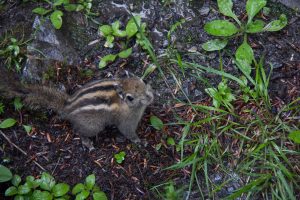
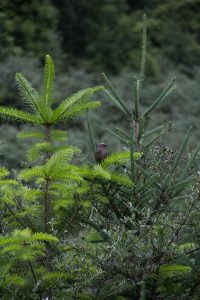
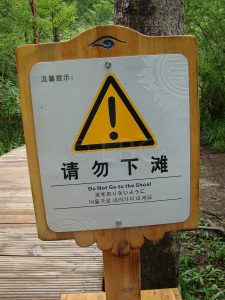
People in the Park and other assorted things
About eight hundred or so residents live in the six traditional villages within the park. However, there are moves to encourage the villagers to move, to reduce the impact of human habitation on the ecosystem.
- As a result there are no camping facilities or other official accomodation for visitors.
- You can visit some of the villages, the easiest to reach is the one close to the Visitor Centre, which also has lots of trinkets for sale.
- There are also limited food outlets (see the note above regarding the Tourist Centre). Have your picnic at one of the rest stops around the toilet facilities and deposit your rubbish appropriately in the bins provided, or take it home.
- If you visit when there’s been enough rain and the rivers and lakes are flowing, there are a number of beautiful waterfalls. A good place to see some of the prettiest is along the south western arm where there is a string of lakes feeding each other.

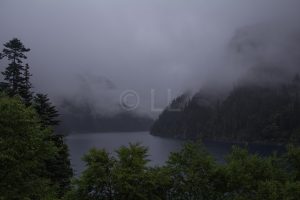
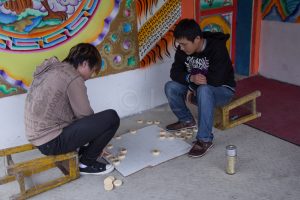
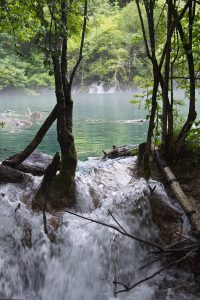
The Lakes and Mountains
The local airport, though some distance from the park, is (or was at the time of our visit) the third highest in China, which gives an idea of the elevation. In some places this reaches more than 4,800metres and the terrain and vegetation is distinctly apline – there is even a glacier nearby – the Dagu Glacier. The air is cool all year round and there is snow in winter.
- Though you’re unlikely to see any, the Giant panda does live within the park and gives its name to the Panda Lake. You can see bamboo groves along the walkway near this lake.
- One of the most beautiful lakes is the clear turquoise lake, Peacock Riverbed, part of the Five Flower Lake, where there are hundreds, if not thousands of fallen trees clearly visible in the water. This is a larger, bluer version of a section of its twin – Dove Lake in Tasmania, Australia.
- The Five Colour lake is at the extreme end of the south eastern leg of the road, but is worth the journey, although it may not be easy to find a good vantage point from where you can actually see the five distinct shades of the water, which come from mineral deposits.
- The lakes are very clear partly because they come from high in the mountains and there is little atmospheric pollution. The wide variety of colours including blues, greens and even purple comes from mineral deposits in the area, with various shades of blue / turquoise being the most common.
- The water levels can vary as much as around five metres depending on the amount of rain and snow melt they are receiving. Many also ice over during the winter.
- The different water levels and diverse ecology combined with varying seasonal conditions and temperatures make Jiuzhaigou a popular destination for photographers and nature lovers who will have different things to see throughout the year.
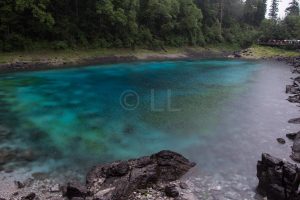


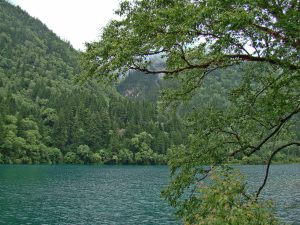
For more information on the Park and the general area, the web link has quite useful information including some of the other nearby places worth visiting, although some of the information hasn’t been updated recently. There is information about local villages and there is a good map, showing roads and walking paths, villages and toilets. Bring your lunch with you, the Tourist Centre is crowded and you may find the choices limited.
images ©LL







This Post Has 0 Comments